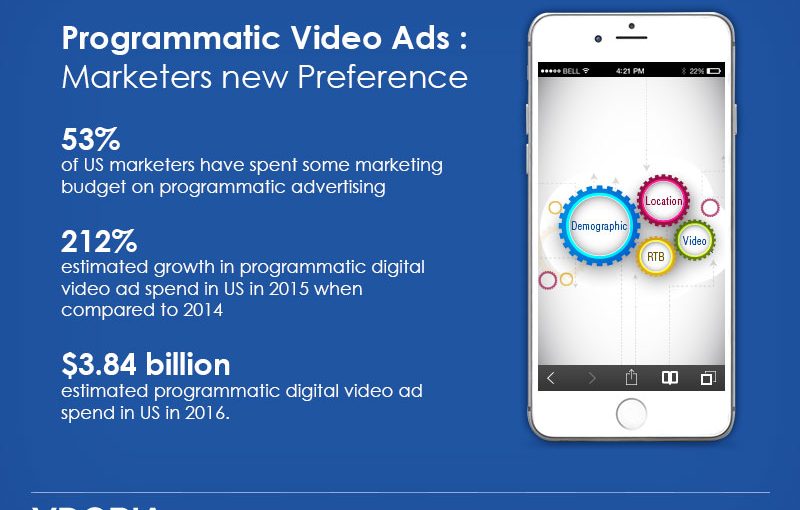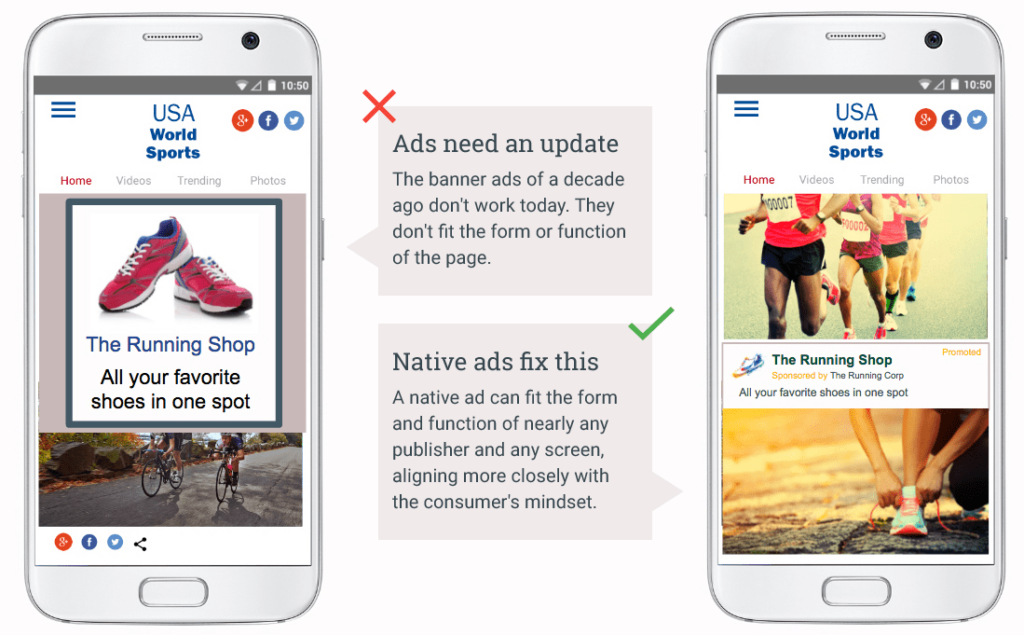
Image from Chocolate Platform
Digital marketing is constantly evolving, and programmatic mobile advertising is one of the most powerful tools in today’s landscape.
Programmatic mobile advertising is a digital marketing strategy involving the automated buying and selling of mobile ads through real-time bidding (RTB) and data-driven algorithms.
This method uses technology to streamline the ad-buying process, allowing advertisers to target specific audiences with personalized and relevant advertisements on mobile devices, leading to higher engagement and conversion rates.
Programmatic mobile advertising revolutionizes digital marketing, giving advertisers remarkable campaign control and efficiency.
This article will explore the power of mobile programmatic advertising and how it transforms how businesses connect with consumers in the digital world.
- The Benefits of Programmatic Mobile Advertising
- Challenges and Solutions in Programmatic Mobile Advertising
- Best Practices for Implementing Programmatic Mobile Advertising in Your Digital Marketing Strategy
- The Future of Programmatic Mobile Advertising: Trends and Innovations to Watch Out For
- Harness the Power of Programmatic Mobile Advertising for Exceptional Digital Marketing Results
- FAQ Section
- 1. What exactly is programmatic mobile advertising, and how does it differ from traditional advertising?
- 2. What are the key benefits of incorporating programmatic strategies into mobile advertising campaigns?
- 3. How can advertisers measure the success of their programmatic mobile advertising campaigns?
- 5. Is programmatic mobile advertising suitable for businesses of all sizes, or is it more geared toward larger enterprises?
- 5. How can businesses get started with programmatic mobile advertising, and what resources are available for further learning?
The Benefits of Programmatic Mobile Advertising
Let’s explore the numerous benefits of programmatic mobile advertising that have revolutionized the digital marketing industry.
Automation: The entire process, from ad placement to optimization, is automated. Advertisers use demand-side platforms (DSPs) to set parameters and algorithms that determine when and where their ads will be displayed. This efficiency offered by programmatic mobile advertising frees marketers’ time to focus on other strategic initiatives.
Data-Driven Targeting: It allows for precise targeting, ensuring that ads are delivered to the right audience at the right time. Programmatic mobile advertising uses data analysis and audience segmentation to target specific demographics, behaviors, and interests.
This improves engagement rates and increases the chances of conversion and ROI.
Cross-Device Targeting: Programmatic mobile advertising allows advertisers to reach users across multiple devices, ensuring a cohesive and consistent advertising experience as users move between smartphones, tablets, and other connected devices.
Real-Time Bidding (RTB): You can bid for ad impressions in real-time through automated auction processes. This enables quick and efficient ad placements based on user data and preferences.
Efficient Budget Allocation: Programmatic advertising allows for efficient budget allocation by focusing spending on the most valuable impressions. In this case, you can set bidding strategies, allocate budgets based on campaign goals, and avoid wasted spend on less impactful impressions.
Wide Range of Ad Formats: This approach supports various ad formats, including display ads, video ads, native ads, and interactive rich media. This flexibility enables advertisers to choose the format that aligns with their campaign objectives and engages their target audience effectively.
Real-Time Optimization: Advertisers can adjust their campaigns based on performance metrics, ensuring that the ads deliver the desired results and maximize return on investment.
Challenges and Solutions in Programmatic Mobile Advertising
While programmatic mobile advertising offers numerous benefits, there are also challenges that marketers face in utilizing this powerful tool effectively.
Understanding these challenges and finding solutions is essential for maximizing the impact of programmatic mobile advertising on your digital marketing strategy.
Ad Fraud
With the rise of programmatic advertising, fraudulent activities have also increased. Ad fraud involves fake impressions, clicks, and conversions, leading to wasted ad spend and skewed campaign performance.
To combat this, you can implement ad fraud detection technologies and work with trusted ad networks to ensure transparency and accountability.
Ad Viewability
Ensuring users see ads in the fast-paced and mobile-centric digital landscape is crucial. You must optimize your ad placements and use technologies to track ad viewability.
This ensures their ads have a higher chance of being seen and engaging the right audience.
Privacy Concerns and Data Usage Regulations
This can also pose challenges in programmatic mobile advertising. Marketers must ensure compliance with data protection laws and communicate transparently with users about data collection and usage.
Best Practices for Implementing Programmatic Mobile Advertising in Your Digital Marketing Strategy

Image from Think With Google
Programmatic mobile advertising has emerged as a game-changer for businesses looking to reach their target audience more effectively and efficiently.
However, to truly harness the power of programmatic mobile advertising, it is crucial to follow certain best practices.
Define Campaign Objectives
The first best practice is clearly defining your campaign objectives and target audience. Understanding who you want to reach and what actions you want them to take will help you set up your programmatic mobile campaigns effectively.
Select Your Data Sources
Next, it is essential to select your data sources carefully. Quality data is the backbone of programmatic advertising, so working with reliable data providers will ensure you reach the right audience with your ads.
Regularly Monitor and Optimize Your Campaigns
Another best practice is to monitor and optimize your campaigns constantly. Programmatic mobile advertising allows for real-time tracking and performance measurement.
By monitoring your campaigns closely, you can identify underperforming areas and make data-driven optimizations to maximize results.
Creative Optimization
Additionally, creative optimization is crucial in programmatic mobile advertising. Experiment with different ad formats, designs, and messages to capture your audience’s attention and drive engagement.
Regularly Test Campaigns
Lastly, regularly test and learn from your campaigns. You can uncover valuable insights to inform future campaign optimizations by testing different targeting strategies, ad placements, and creatives.
The Future of Programmatic Mobile Advertising: Trends and Innovations to Watch Out For
You must stay updated with the latest trends and innovations as technology advances and consumer behavior shifts.
One emerging trend in programmatic mobile advertising is the rise of artificial intelligence (AI) and machine learning.
With AI-powered algorithms, marketers can optimize their campaigns, making real-time adjustments based on user data and predictive analytics.
This improves campaign performance and enhances user experience by delivering more relevant and personalized ads.
Another trend to watch out for is by integrating with other programmatic advertising channels , such as social media and connected TV.
By combining programmatic capabilities with these platforms, marketers can create cross-channel campaigns that reach consumers wherever they are.
This approach allows for better targeting and more cohesive messaging, increasing engagement and conversion rates.
In addition, the growing importance of data privacy and compliance regulations is shaping the future of programmatic mobile advertising.
You must adapt to stricter data protection measures and ensure your campaigns comply with regulations like the General Data Protection Regulation (GDPR) and the California Consumer Privacy Act (CCPA).
This includes obtaining proper consent, implementing secure data handling practices, and being transparent with users about their data use.
Harness the Power of Programmatic Mobile Advertising for Exceptional Digital Marketing Results
The power of programmatic mobile advertising cannot be overstated. As we have discussed, this advertising method is revolutionizing digital marketing by leveraging AI and machine learning to optimize campaigns and deliver personalized ads.
Furthermore, the ongoing shift towards mobile-first and mobile-only experiences is driving the innovation of new ad formats and placements.
From interactive video ads to immersive augmented reality experiences, programmatic mobile advertising is becoming more immersive and engaging.
The integration of programmatic advertising with other channels is also expanding marketers’ reach and improving engagement rates.
However, it is crucial to understand that with these advancements come new responsibilities.
With the right strategies, technologies, and partnerships, programmatic mobile advertising can revolutionize your digital marketing efforts and drive impactful results.
FAQ Section
1. What exactly is programmatic mobile advertising, and how does it differ from traditional advertising?
Programmatic mobile advertising involves automated, data-driven processes for buying and placing mobile ads in real-time auctions. It differs from traditional advertising by utilizing advanced technologies and algorithms for more targeted and efficient campaigns.
2. What are the key benefits of incorporating programmatic strategies into mobile advertising campaigns?
Benefits include enhanced targeting precision, real-time optimization, efficient budget allocation, and the ability to reach specific demographics based on data insights. These factors contribute to higher engagement and improved return on investment (ROI).
3. How can advertisers measure the success of their programmatic mobile advertising campaigns?
Success can be measured through key performance indicators (KPIs) such as click-through rates, conversion rates, and return on ad spend. Advertisers can also use analytics tools to track user engagement, allowing for real-time adjustments to optimize campaign performance.
5. Is programmatic mobile advertising suitable for businesses of all sizes, or is it more geared toward larger enterprises?
Programmatic mobile advertising is scalable and adaptable, making it suitable for businesses of all sizes. Small businesses can benefit from its efficiency and targeting capabilities, while larger enterprises can leverage its scale and real-time optimization features.
5. How can businesses get started with programmatic mobile advertising, and what resources are available for further learning?
Getting started involves understanding the basics, choosing a reliable demand-side platform (DSP), and defining campaign objectives. Various online resources, webinars, and industry publications provide valuable insights for businesses looking to successfully explore and implement programmatic mobile advertising.






0 Comments